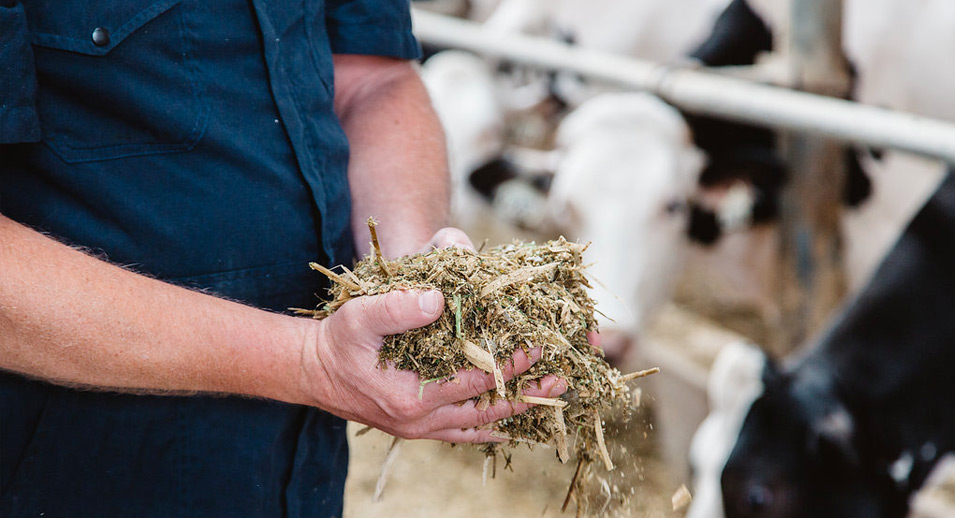Corn Processing, How to Milk the Most of It?
- August 16, 2022
Despite minimizing purchased feed costs is constantly on the radar of dairy producers and feed advisors, the increasing prices of concentrates have made of it a priority. As stated in the previous articles, the best way to reduce the need for purchased feed is to harvest excellent quality forage, and therefore it should be prioritized and where most of efforts and resources should be invested.

However, we can still do more to increase the income over feed cost under the current market scenario. One of the remaining opportunities is to enhance the efficiency of cereal utilization. This article will focus on the importance of optimizing corn processing, a common cereal being included in most dairy rations, and how to evaluate it.
All About Particle Size
Corn, as well as other cereals, is an important part of dairy diets serving primarily as source of energy in the form of starch. Starch content in corn is fairly constant (around 70% of the total DM), nevertheless, its digestibility and site of digestion can be modified by grinding. In general terms, the reduction of particle size will improve the efficiency of use of corn starch by your cows due to different mechanisms:
- a greater surface area is exposed to rumen microorganisms, allowing for greater extent of rumen fermentation
- under the appropriate rumen conditions, more microbial protein will be synthesized
- digestibility in the intestine won’t be affected
- total-tract digestibility of starch increases
- greater energy and protein supply per unit of starch fed
- less starch excreted in the feces, meaning less waste
However, the finest grind is not always the best grind. To establish the optimal degree of corn grinding, several factors, such as the preservation method of corn and starch content of the diet should be taken into consideration.
Preservation Method
Properly ensiled high-moisture corn has a greater rumen availability than dry corn in part due to the hydrated state of the starch granules, and because the protein matrix covering the starch granules is broken down during the ensiling process. Therefore, depending on the moisture content and the time of ensiling, high-moisture corn would require a coarser grind than dry corn to maximize starch utilization while avoiding rumen upset.
The main guidelines for evaluating corn processing are shown in Table 1. Guidelines for two methods are provided: the standard method, performed by commercial labs using a 14-screens system (RoTap) to calculate the mean particle size of the grain, and an on-farm method using a 5-screen system to evaluate the proportions retained in each screen.
As the moisture content of corn increases, a larger particle size or a greater proportion of the sample retained in the larger opening screens is recommended. Regarding dry corn, it is important to notice that despite most available data has evaluated the effect of ground corn sized > 700 microns, there is data suggesting that grinding corn to less than 400 microns could be beneficial, as every 100-micron reduction in mean particle size has been associated with a 2% increase ruminal starch digestion (Goeser and Shaver, 2020).
Looking at Starch Content and Diet Composition
Other key factor to consider when establishing the optimal processing for corn is the starch content and general composition of the diet.
For instance, a study (Fredin et al., 2015) reported that whereas coarse-ground corn was best for cows consuming low in starch diets (< 20%), fine-ground corn allowed the best performance when cows were diets with higher starch concentration (27 %).
In addition, other factors like forage fiber and total fiber content of the diet should also be kept in mind when determining the optimal degree of corn processing since fiber plays an important role maintaining adequate ruminal conditions, particularly in high starch rations. In a recent study feeding diets with limited levels of forage fiber (18%) and high starch (> 27%), finely ground corn decreased milk and fat yield compared to a medium grind. Despite finer grind increased starch digestion in the rumen, it did not increase total-tract starch digestibility, and decreased fiber digestion (Allen et al., 2021).
It is important to notice that in these studies, the corn was included in the diet at the same levels, but varying in grinding size. In a practical setting, there is an opportunity to adjust the corn inclusion rate depending on the type of corn and level of processing available at the farm .
Diet Correction or Evaluation
These guidelines and concepts could be used to both apply corrective actions under problematic situations or to evaluate potential feeding adjustments to increase efficiency. To evaluate these and other factors affecting effective feed use on your farm, and guide you on how to adjust your nutritional program accordingly, don’t hesitate to contact us. Likewise, as the processing of grains and the diets are adjusted, you could take advantage of PROFILab3 to make sure the ruminal fermentation and your fat test go in the right direction.
| Corn Type | Recommendations | |||||
| RoTap1 | 5 Screen System, % of the sample2 | |||||
| Mean Particle Size, microns | 4,750 micron | 2,360 micron | 1,180 micron | 600 micron | Pan | |
| Dry (>75% DM) |
<750 | 0 | <10 | 30 | 50 | <20 |
| High moisture (70-75% DM) |
750-1,000 | 25 | 50 | 25 | 0 | 0 |
| High moisture (< 70% DM) |
1,000-2,000 | 75 | 25 | 0 | 0 | 0 |
1metod described by ASAE S319.4, 14 sieves and Ro-Tap shaking.
2M. Hutjents, Univ. Illinois
3As of August 2022, PROFILab is offered in Québec and Atlantic Canada only.










